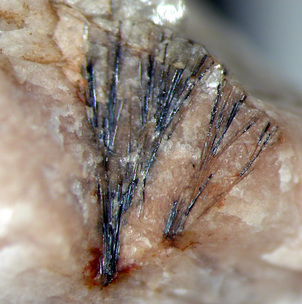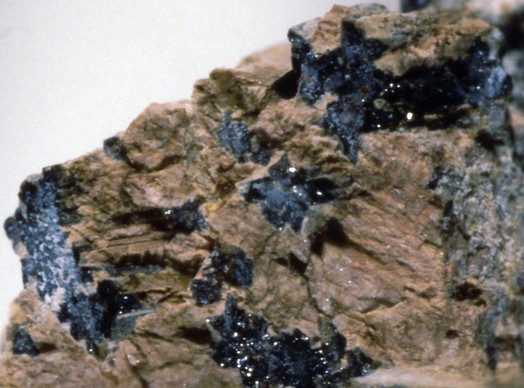Kobeite-(Y)
A valid IMA mineral species - grandfathered
This page is currently not sponsored. Click here to sponsor this page.
About Kobeite-(Y)
Formula:
(Y,U)(Ti,Nb)2(O,OH)6 (?)
Colour:
Black to dark brown
Lustre:
Vitreous, Resinous
Hardness:
5½
Specific Gravity:
4.60
Crystal System:
Isometric
Member of:
Name:
Originally named simply kobeite for the type locality of Kobe, Kyoto prefecture, Japan (Kobe-mura, Kyoto prefecture - presently Oyama-cho). The suffix was added in 1987 to denote the predominate rare-earth element.
A metamict member of the euxenite group.
Unique Identifiers
Mindat ID:
2232
Long-form identifier:
mindat:1:1:2232:9
GUID
(UUID V4):
(UUID V4):
232e0f6e-67dc-47d1-91c0-745ff9d84c6c
IMA Classification of Kobeite-(Y)
Approved, 'Grandfathered' (first described prior to 1959)
IMA status notes:
Renamed by the IMA
First published:
1950
Classification of Kobeite-(Y)
4.DG.05
4 : OXIDES (Hydroxides, V[5,6] vanadates, arsenites, antimonites, bismuthites, sulfites, selenites, tellurites, iodates)
D : Metal: Oxygen = 1:2 and similar
G : With large (+- medium-sized) cations; chains of edge-sharing octahedra
4 : OXIDES (Hydroxides, V[5,6] vanadates, arsenites, antimonites, bismuthites, sulfites, selenites, tellurites, iodates)
D : Metal: Oxygen = 1:2 and similar
G : With large (+- medium-sized) cations; chains of edge-sharing octahedra
8.3.12.1
8 : MULTIPLE OXIDES CONTAINING NIOBIUM,TANTALUM OR TITANIUM
3 : AB2O6
8 : MULTIPLE OXIDES CONTAINING NIOBIUM,TANTALUM OR TITANIUM
3 : AB2O6
18.4.7
18 : Niobates and Tantalates
4 : Niobates and tantalates containing both U and rare earths
18 : Niobates and Tantalates
4 : Niobates and tantalates containing both U and rare earths
Mineral Symbols
As of 2021 there are now IMA–CNMNC approved mineral symbols (abbreviations) for each mineral species, useful for tables and diagrams.
| Symbol | Source | Reference |
|---|---|---|
| Kob-Y | IMA–CNMNC | Warr, L.N. (2021). IMA–CNMNC approved mineral symbols. Mineralogical Magazine, 85(3), 291-320. doi:10.1180/mgm.2021.43 |
Physical Properties of Kobeite-(Y)
Vitreous, Resinous
Transparency:
Transparent, Translucent
Colour:
Black to dark brown
Streak:
Reddish brown
Hardness:
5½ on Mohs scale
Tenacity:
Brittle
Parting:
Perpendicular to the length, probably a parting.
Fracture:
Conchoidal
Density:
4.60 g/cm3 (Measured) 4.13 g/cm3 (Calculated)
Optical Data of Kobeite-(Y)
Type:
Isotropic
RI values:
n = 2.205(5)
Birefringence:
Isotropic minerals have no birefringence
Surface Relief:
Very High
Comments:
Coffee-brown to brownish yellow in thin section.
Chemistry of Kobeite-(Y)
Mindat Formula:
(Y,U)(Ti,Nb)2(O,OH)6 (?)
Crystallography of Kobeite-(Y)
Crystal System:
Isometric
Cell Parameters:
a = 5.039(16) Å
Unit Cell V:
127.95 ų (Calculated from Unit Cell)
Z:
1
Comment:
Metamict
X-Ray Powder Diffraction
Powder Diffraction Data:
| d-spacing | Intensity |
|---|---|
| 2.89 Å | (100) |
| 2.506 Å | (40) |
| 1.776 Å | (80) |
| 1.514 Å | (70) |
| 1.154 Å | (30 broad) |
| 1.126 Å | (30 broad) |
| 1.027 Å | (20 broad) |
Comments:
Shiraishi pegmatite, Japan. The data are from Hutton (1957). Data collected after heating sample for one hour at 620°C in air.
Geological Environment
Paragenetic Mode(s):
| Paragenetic Mode | Earliest Age (Ga) |
|---|---|
| Near-surface Processes | |
| 26 : Hadean detrital minerals | |
| Stage 4b: Highly evolved igneous rocks | >3.0 |
| 34 : Complex granite pegmatites |
Type Occurrence of Kobeite-(Y)
General Appearance of Type Material:
Mineral is prismatic in habit and the crystals are grouped in twin-like forms.
Place of Conservation of Type Material:
National Science Museum, Tokyo, Japan (type).
Geological Setting of Type Material:
Granite pegmaitites.
Associated Minerals at Type Locality:
Reference:
Takubo, J., Ukai, Y., Minato, T. (1950) Studies on the minerals containing rare elements (Part II) A new mineral found in Kobe-mura, Kyoto Prefecture, Japan. Chishitsugaku Zasshi: 56: 509-513.
Other Language Names for Kobeite-(Y)
Japanese:河辺石
Relationship of Kobeite-(Y) to other Species
Member of:
Other Members of this group:
| Euxenite-(Y) | (Y,Ca,Ce,U,Th)(Nb,Ta,Ti)2O6 | Orth. mmm (2/m 2/m 2/m) : Pbcn |
| Fersmite | (Ca,Ce,Na)(Nb,Ta,Ti)2(O,OH,F)6 | Orth. mmm (2/m 2/m 2/m) : Pbcn |
| Loranskite-(Y) | (Y,Ce,Ca)ZrTaO6 (?) | |
| Tanteuxenite-(Y) | Y(Ta,Nb,Ti)2(O,OH)6 | Orth. mmm (2/m 2/m 2/m) : Pbcn |
| Uranopolycrase | (U4+,Y)(Ti,Nb)2O6 | Orth. mmm (2/m 2/m 2/m) : Pbcn |
| Yttrocrasite-(Y) | (Y,Th,Ca,U)(Ti,Fe)2(O,OH)6 | Amor. |
Related Minerals - Strunz-mindat Grouping
| 4.DG.05 | Euxenite-(Y) | (Y,Ca,Ce,U,Th)(Nb,Ta,Ti)2O6 |
| 4.DG.05 | Fersmite | (Ca,Ce,Na)(Nb,Ta,Ti)2(O,OH,F)6 |
| 4.DG.05 | Loranskite-(Y) | (Y,Ce,Ca)ZrTaO6 (?) |
| 4.DG.05 | Tanteuxenite-(Y) | Y(Ta,Nb,Ti)2(O,OH)6 |
| 4.DG.05 | Uranopolycrase | (U4+,Y)(Ti,Nb)2O6 |
| 4.DG.05 | Yttrocrasite-(Y) | (Y,Th,Ca,U)(Ti,Fe)2(O,OH)6 |
| 4.DG.10 | Clinofergusonite-(Y) | YNbO4 |
| 4.DG.10 | Clinofergusonite-(Nd) | (Nd,Ce)NbO4 |
| 4.DG.10 | Clinofergusonite-(Ce) | CeNbO4 |
| 4.DG.10 | Yttrotantalite-(Y) | (Y,U,Fe2+)(Ta,Nb)(O,OH)4 |
| 4.DG.15 | Foordite | Sn2+Nb2O6 |
| 4.DG.15 | Thoreaulite | Sn2+Ta2O6 |
| 4.DG.20 | Raspite | Pb(WO4) |
Other Information
Notes:
Metamict, radioactive.
Health Risks:
Radioactive
Internet Links for Kobeite-(Y)
mindat.org URL:
https://www.mindat.org/min-2232.html
Please feel free to link to this page.
Please feel free to link to this page.
Search Engines:
External Links:
Mineral Dealers:
References for Kobeite-(Y)
Localities for Kobeite-(Y)
Locality List
 - This locality has map coordinates listed.
- This locality has map coordinates listed.
 - This locality has estimated coordinates.
ⓘ - Click for references and further information on this occurrence.
? - Indicates mineral may be doubtful at this locality.
- This locality has estimated coordinates.
ⓘ - Click for references and further information on this occurrence.
? - Indicates mineral may be doubtful at this locality.
 - Good crystals or important locality for species.
- Good crystals or important locality for species.
 - World class for species or very significant.
(TL) - Type Locality for a valid mineral species.
(FRL) - First Recorded Locality for everything else (eg varieties).
- World class for species or very significant.
(TL) - Type Locality for a valid mineral species.
(FRL) - First Recorded Locality for everything else (eg varieties).
All localities listed without proper references should be considered as questionable.
Austria | |
| Collection of Natural History Museum +3 other references |
Canada | |
| T.S. Ercit - 2002 Rochester Min. ... |
Italy | |
| Bedognè et al. (1993) |
Japan | |
| Yukikazu Ogoshi (2011) |
| Pavel.M. Kartashov (n.d.) |
| Alfredo Petrov specimens | |
| Takubo et al. (1950) |
| Alfredo Petrov specimen |
Mexico | |
| Prol-Ledesma et al. (2012) |
New Zealand | |
| Hutton (1957) |
Norway | |
| Åmli (1974) |
Quick NavTopAbout Kobeite-(Y)Unique IdentifiersIMA Classification Classification Mineral SymbolsPhysical Properties Optical Data Chemistry Crystallography X-Ray Powder DiffractionGeological EnvironmentType Occurrence Other LanguagesRelationshipsStrunz-MindatOther InformationInternet Links References Localities Locality List








 symbol to view information about a locality.
The
symbol to view information about a locality.
The 



Hataga pegmatite, Hataga, Hiroshima City, Hiroshima Prefecture, Japan